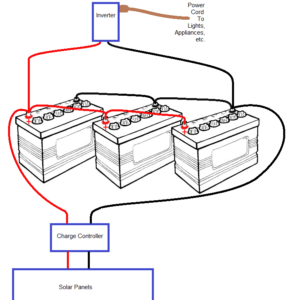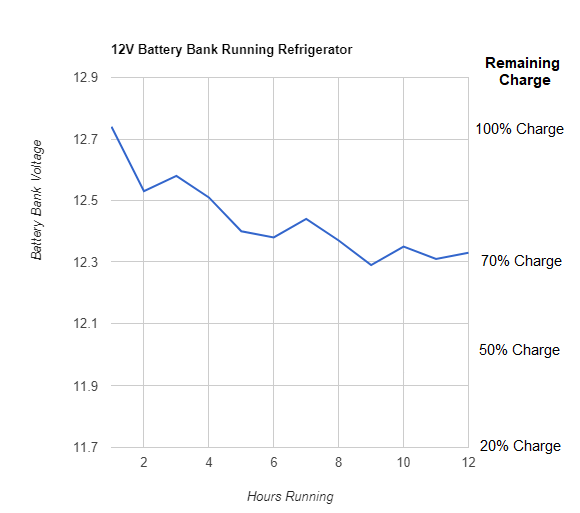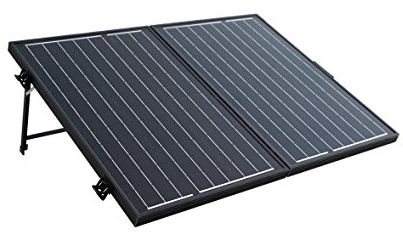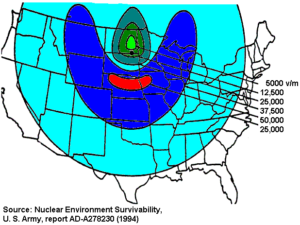Here’s an interesting article. Hope we never need to put it to the test!
Blog
Catching Fish Without Gear
Running a Refrigerator With Batteries
 Consider an extreme situation where an electromagnetic pulse (EMP) or other disaster or attack closes down our nation’s electrical grid for weeks, months, or longer. After an EMP attack, it’s unlikely that our local medical service will continue with business as usual. Drug deliveries to our local pharmacies will stop because delivery trucks won’t run and drug manufacturers will be shut down. The pharmacies will soon run out of most medications. In addition to all the other problems such an event could cause, illnesses that are usually considered minor inconveniences, can become life-threatening situations.
Consider an extreme situation where an electromagnetic pulse (EMP) or other disaster or attack closes down our nation’s electrical grid for weeks, months, or longer. After an EMP attack, it’s unlikely that our local medical service will continue with business as usual. Drug deliveries to our local pharmacies will stop because delivery trucks won’t run and drug manufacturers will be shut down. The pharmacies will soon run out of most medications. In addition to all the other problems such an event could cause, illnesses that are usually considered minor inconveniences, can become life-threatening situations.
Plainly, you just cannot afford to risk becoming sick from eating leftover food that has not been kept refrigerated. Having electricity to run a refrigerator becomes, not a luxury, but a necessity to keep yourself and your family healthy. Plus, it’s nice to have some ice occasionally!
We ran an experiment recently at our home in Pocahontas, to learn if it’s feasible to have refrigeration in a long-term “no power” situation. We have two full-sized refrigerators in our home. One is an old model from the 1980’s. The other is an Energy Star compliant model from 2012.

We created a battery “bank” of three 12-volt Ever Start-Marine Maxx, Marine & RV batteries (about $110 each at Walmart), wired in parallel to create one long-life 12-volt battery. These are “deep cycle” batteries designed to repeatedly have their charge drawn down by up to 80%, then recharged. (Watch your battery charge, because drawing them down too low can damage them.)
We attached to the battery bank a 1000 watt “inverter” which converts the 12V DC battery power to 120V AC power our refrigerator needs. At the start of the test, our battery bank was fully charged to a level of 12.75 volts. Over time, as the batteries are used up, that voltage drops, so with a digital multimeter it’s easy to track the remaining battery charge over time as the energy is used up.
First we plugged our old 1980’s refrigerator into the inverter and switched the battery power on. Within seconds, the inverter sounded its alarm and cut power to the refrigerator. The old refrigerator just draws too much power for the inverter to handle. Then we plugged the modern Energy Star refrigerator into the inverter, and it ran just fine. (We plan to replace that old refrigerator soon, because new ones are so efficient, they pay for themselves in about 2 years of use, and after that they are putting money into your pocket, vs. paying the electric company cash to let you run an inefficient older model.)
So, with the refrigerator successfully running on battery power, the test begins. We recorded the refrigerator temperature and the battery level hourly for the next 12 hours.
After 12 hours running only on the three “car batteries”, the temperature inside the refrigerator remained right were it was set at the beginning: 40 degrees F.
After 12 hours, the battery bank charge dropped by just 30%! At that rate after 24 hours, on batteries with no recharging, we’d still have 40 percent of our battery charge left. That means there’s plenty of extra power to run some LED lighting in the house, to run a fan to cool us, and to recharge our AA and AAA batteries for our radio, flashlights, etc.

Soon we’ll do a second experiment, running the refrigerator on batteries only for 3 full days, with the batteries being recharged in the daytime using  our $195 portable solar panels*. Our first test, described above, makes it seem reasonable to expect that this second test will be successful, because in most cases, 12 hours is about all you’d need to run on batteries alone before the sun comes back out and provides the power to both run the refrigerator and recharge the batteries for the next night of use. A previous test we ran proved that the solar panels can recharge our depleted battery bank with just a few hours of sunlight.
our $195 portable solar panels*. Our first test, described above, makes it seem reasonable to expect that this second test will be successful, because in most cases, 12 hours is about all you’d need to run on batteries alone before the sun comes back out and provides the power to both run the refrigerator and recharge the batteries for the next night of use. A previous test we ran proved that the solar panels can recharge our depleted battery bank with just a few hours of sunlight.
But, you may ask, what do you do when you have a few days of overcast skies without sunshine. Here are some thoughts on that:
- Even on cloudy days, the solar panels still provide some power to recharge the batteries, though not nearly as much as on sunny days. So you may have to cut back on having the refrigerator powered day and night, but it can still be run several hours a day to keep things cool.
- Cloudy days and/or winter days mean less sun, meaning less heat in the atmosphere, so a well-insulated refrigerator can keep food cold, as long as it’s not opened, for a long time while the battery bank waits for a solar recharge. Research shows that duct-taping rigid foam insulation board around a refrigerator, covering sides, top, and doors (but not where air must circulate in back) can cut the refrigerator’s energy needs in half.
- Forty degrees is the ideal temperature for a refrigerator, but when solar power is low, you can always bump the fridge temperature setting up a bit. This will shorten the storage life of foods stored, but it will still be a lot better than leaving things out at room temperature while you wait for sunshine to provide full power again.
- You can supplement solar power with wind power or even a bicycle-like manually cranked generator.
- If bad comes to worse, you might lose some food if there’s just not enough power available to run the refrigerator for a few days, but on all the days you DO have power, you’ll be a lot better off than people who have NO refrigeration.
6 Old-Time Ways to Check If Your Food Has Spoiled
If food becomes scarce, it could be tempting to eat compromised food. It’s hard to throw out food when there isn’t much to eat. That’s why deaths from spoiled foods often rise during times of famine.
After Clean Air and Shelter…
After clean air and shelter, the next-most important survival need is clean drinking water. Here’s some good information on how to assure your water is safe to drink.
How To Build A Shelter/Panic Room…
… Without Being Noticed.
A bit over the top, but an interesting read of you’re so inclined.
What is an EMP?

An electromagnetic pulse (EMP) is a huge energy burst that can “fry” electrical wiring and all electrical components over hundreds or even thousands of miles, making them useless and not repairable. An EMP can “kill” the computers that run our national electrical grid, as well as our cell phones AND our land line phones, TV’s, airplanes, and all cars that contain computer chips (all cars made since about 1980).
After a strong EMP, the lights won’t come on. Pocahontas Water Works won’t be pumping water. Texas won’t be pumping natural gas to us. The hospital’s backup generator will probably be fried, and they and the pharmacies will face people pressing at the doors for whatever drugs are left in stock.
Businesses don’t stock huge inventories anymore. They depend on 2nd-day delivery to keep them from running out of things, and those deliveries will stop. Food delivery to stores will stop. Refrigeration will be a thing of the past until the power comes back on, and that could take months or even years.
And that’s just the beginning.
Think of it this way: if an enemy’s 10 large nuclear weapons wiped out America’s 10 largest cities, the gasoline generators in Pocahontas would still work, our cars would still work, our electrical devices would still work and we’d be in fairly good shape, just waiting for the electricity to come back on. But ONE well-placed nuclear weapon 200 miles above mid-America could shut down our whole country, potentially for years, because even if you get the power on, the electrical components in the devices are fried and won’t work. And the companies and their machines that could manufacture new devices are fried, too.
An EMP can be generated by strong solar flares (sun spots) or a burst of electromagnetic radiation created by small-but-optimized nuclear explosions high in the atmosphere. The resulting rapidly changing electric and magnetic fields may couple with electrical and electronic systems to produce devastating current and voltage surges over a huge area. Such an optimized EMP device is probably the world’s most devastating weapon, and most people aren’t even aware such devices exist.
In July 1962, the US carried out the Starfish Prime test, exploding a 1.44 megaton bomb, small by modern standards, 250 miles above the mid-Pacific Ocean. This demonstrated that the effects of a high-altitude nuclear explosion were much larger than had been previously calculated. Starfish Prime made those effects known to the public by causing electrical damage in Hawaii, about 900 miles away from the detonation point, knocking out about 300 streetlights, setting off numerous burglar alarms and damaging a microwave link.
In 1962, the Soviet Union also performed three EMP-producing nuclear tests in space over Kazakhstan, the last in the “Soviet Project K nuclear tests”. Although these weapons were much smaller (300 kiloton) than the Starfish Prime test, they were over a populated, large land mass and at a location where the Earth’s magnetic field was greater; the damage caused by the resulting EMP was reportedly much greater than in Starfish Prime. The geomagnetic storm–like E3 pulse from Test 184 induced a current surge in a long underground power line that caused a fire in the power plant in the city of Karaganda.
For one of the K Project tests, Soviet scientists instrumented a 350 mile section of telephone line in the area that they expected to be affected by the pulse. The monitored telephone line was divided into sub-lines of 25 to 50 miles in length, separated by repeaters. Each sub-line was protected by fuses and by gas-filled overvoltage protectors. The EMP from Test 184 blew all of the fuses and fired all of the overvoltage protectors in all of the sub-lines.

Published reports, including a 1998 IEEE article, have stated that there were significant problems with ceramic insulators on overhead electrical power lines during the tests. A 2010 technical report written for Oak Ridge National Laboratory stated that “Power line insulators were damaged, resulting in a short circuit on the line and some lines detaching from the poles and falling to the ground.”
The E1 pulse is the very fast component of nuclear EMP. E1 is a very brief but intense electromagnetic field that induces very high voltages in electrical conductors. E1 causes most of its damage by causing electrical breakdown voltages to be exceeded. E1 can destroy computers and communications equipment and it changes too quickly (nanoseconds) for ordinary surge protectors to provide effective protection against it.
Older, vacuum tube based equipment is generally much less vulnerable to nuclear EMP than solid state equipment, which is much more susceptible to damage by large but brief voltage and current surges. Soviet Cold War-era military aircraft often had avionics based on vacuum tubes because solid-state capabilities were limited and vacuum-tube gear was believed to be more likely to survive.
Here are just a few ways an EMP-optimized device could be used against the USA:
- From jet planes, easily modified to fly at high enough altitudes to create effective EMP attacks.
- From small missiles launched from within the USA, or from ships just off-shore.
- From high altitude balloons like weather balloons.
- From low orbit satellites, placed in orbit by a rogue country.
It’s feared that a terrorist group or nuclear-equipped country could severely cripple the USA, in effect winning a war against us in seconds, by exploding a few nuclear devices high over the US, perhaps launched from cargo ships off the East, West, and Gulf of Mexico coasts. Such an attack has the potential to destroy our nation’s electrical system, as well as “frying” every electrical device from our computers to the microchips controlling our cars and airplanes. In an instant we could find ourselves back in the Victorian Era, relying on steam engines and horsepower from real horses. This is why we prepare.
Heat Without Electricity
 An interesting article worth reading: http://www.survivopedia.com/heat-home-electricity
An interesting article worth reading: http://www.survivopedia.com/heat-home-electricity

